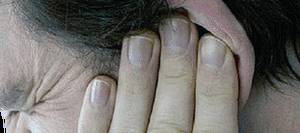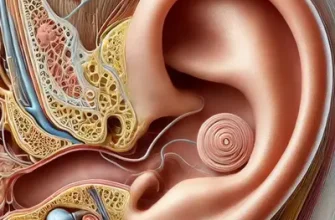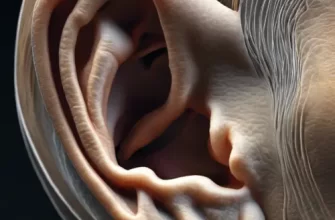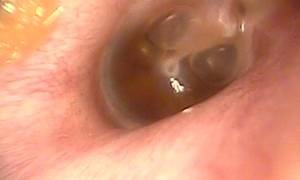Otitis Media with Effusion (OME), also known as “glue ear,” is a common middle ear condition where fluid accumulates behind the eardrum without signs of acute infection. It mostly affects children but can also occur in adults. Unlike acute otitis media, OME doesn’t involve fever or significant ear pain — making it a bit of a silent intruder.
Prevalence of OME by Age Group in Children (Ages 0–12)
This chart shows the prevalence of Otitis Media with Effusion (OME) in children from infancy to early adolescence. The condition is most common in children aged 2–3 years and gradually decreases with age.
What Causes OME?
OME usually follows a cold, upper respiratory infection, or allergic response that leads to eustachian tube dysfunction. When the eustachian tube — responsible for equalizing pressure in the ear — becomes blocked or swollen, fluid builds up in the middle ear.
Common Triggers Include:
- Seasonal allergies
- Sinus infections
- Rapid air pressure changes (e.g., during flights)
- Enlarged adenoids (especially in children)
- Frequent upper respiratory infections
How Common Is It?
OME is incredibly prevalent in children under age 5. According to the CDC, nearly 90% of children experience at least one episode before school age. In adults, it’s less common but still occurs, especially in those with allergies or sinus issues.
Recognizing the Symptoms
Since OME doesn’t cause intense symptoms, it can often go unnoticed. Here’s what to watch for:
In Children:
- Muffled hearing: Children may not respond to their name, ask for repetition, or seem distracted in noisy environments. Teachers often notice the first signs in classrooms.
- Speech delays: Fluid in the middle ear dulls sound perception, which may delay speech development and articulation. Words might be unclear, vocabulary limited, or sentence formation lagging.
- Inattentiveness and behavioral issues: Because they struggle to hear properly, children may seem “in their own world,” leading to frustration or acting out.
- Balance problems: The middle ear helps regulate balance. A child with OME might appear clumsy or unsteady.
- Ear tugging or rubbing: While less common in OME than acute infections, children may touch their ears if the fluid causes pressure or discomfort.
- Frequent asking for increased TV volume: If you notice the volume creeping up — it’s a potential red flag.
- Delayed response to sounds: Parents might notice a pause before a child reacts to sounds, indicating possible processing delays.
- Sleep disturbances: Although not always linked directly, discomfort from ear pressure can subtly disrupt sleep.
Most Common Symptoms Reported in OME Diagnosis (2024)
| Symptom | Reported Cases |
|---|---|
| Hearing Loss | 85 |
| Ear Fullness | 55 |
| Speech Delay | 47 |
| Balance Problems | 22 |
| Ear Pain | 18 |
This chart displays the most frequently reported symptoms associated with Otitis Media with Effusion (OME) in 2024. Hearing loss leads as the dominant symptom, followed by ear fullness and delayed speech development.
In Adults:
- Sensation of fullness or pressure in the ear: Feels like the ear is “plugged,” especially after changes in altitude or post-nasal congestion.
- Mild to moderate hearing loss: Sounds may be dull or distant. Conversations in crowded areas become challenging.
- Tinnitus: A persistent ringing or buzzing in one or both ears is common.
- Difficulty during phone calls: Many adults report that one ear seems to underperform or lag in clarity.
- Frequent need to pop the ears: Attempts to relieve pressure through yawning or chewing might be constant but ineffective.
- Increased difficulty following conversations: Especially in group settings, background noise makes it harder to distinguish speech.
- Sensation of echoing or one’s own voice sounding louder (autophony): A sign of disrupted middle ear acoustics.
OME symptoms often overlap with other ear issues, but the distinguishing factor is their chronic, subtle nature. There’s usually no fever or sharp ear pain — just a lingering sense that something isn’t quite right. Parents and patients should pay attention to communication changes, attention span, and any behavioral shifts.
Diagnostic Methods for OME
Diagnosing OME involves a few non-invasive tests that check for fluid in the middle ear.
1. Otoscopy
Accuracy: 7/10
How it Works: A visual examination using an otoscope to inspect the eardrum for dullness or fluid bubbles.
Cost: Typically included in a primary care visit ($100–$250 or more).
Procedure: The doctor gently inserts a lighted otoscope into the ear canal to view the eardrum. The test takes less than 5 minutes and requires no preparation.
Drawbacks: Subjective; accuracy depends on physician experience and child cooperation.
2. Tympanometry
Accuracy: 9/10
How it Works: Measures eardrum movement in response to air pressure changes. Flattened results usually indicate fluid presence.
Cost: Around $70–$150 in the U.S.
Procedure: A soft probe is inserted into the ear canal, and the machine emits a gentle puff of air to assess how the eardrum responds. It takes 1–2 minutes per ear and is painless.
Preparation: None required. The patient should sit still for accurate results.
Drawbacks: Can be inaccurate if the child moves or cries during the test.
3. Audiometry (Hearing Test)
Accuracy: 8/10
How it Works: Evaluates hearing ability, often revealing conductive hearing loss consistent with OME.
Cost: Approximately $60–$120.
Procedure: The patient wears headphones and responds to tones at various pitches and volumes. In young children, visual reinforcement audiometry (using lights or toys) may be used. Takes about 15–30 minutes.
Preparation: No special prep needed, but it’s ideal if the patient is rested and attentive.
Drawbacks: Requires quiet setting and patient cooperation, which can be tough with toddlers.
Preferred Diagnostic Approach in the U.S.: Most U.S. physicians use a combination of otoscopy and tympanometry as the first-line diagnostic tools. Tympanometry is particularly favored in pediatric clinics due to its objectivity and speed. Audiometry is typically used if hearing loss is suspected or if symptoms persist.
Modern Treatment Options
Effectiveness Rates of OME Treatments After 3 Months
| Treatment | Effectiveness (%) |
|---|---|
| Watchful Waiting | 45% |
| Antibiotics | 53% |
| Nasal Steroids | 30% |
| Tympanostomy Tubes | ⭐ 90% |
| Adenoidectomy | 78% |
This chart compares the effectiveness of common OME (Otitis Media with Effusion) treatments after a 3-month follow-up. Tympanostomy tubes show the highest effectiveness, followed by adenoidectomy, while nasal steroids were the least effective.
Watchful Waiting
For most children, OME resolves naturally within 3 months. Regular monitoring is key.
How it Happens: The physician schedules periodic check-ups (every 4–6 weeks) to monitor fluid levels and hearing. No treatment is given unless symptoms worsen.
Duration: Up to 3 months of observation.
Medications
- Nasal corticosteroids (e.g., fluticasone): sometimes helpful for allergy-related cases
- Antihistamines: rarely used unless allergies are evident
Note: Antibiotics are not recommended as OME isn’t caused by bacteria.
How it Happens: The doctor prescribes a nasal spray to be used daily, usually for 2 to 6 weeks. Parents are advised on proper application technique to maximize effectiveness.
Duration: 2–6 weeks depending on response and severity.
Surgical Interventions
If fluid persists longer than 3 months or affects hearing and development, intervention may be needed.
1. Myringotomy With Tube Insertion
What It Is: A tiny incision is made in the eardrum to place a small ventilation tube.
Brands: T-tubes, Shepard tubes
Effectiveness: 9.5/10
Cost: Around $2,000–$4,000 in the U.S.
How it Happens: This outpatient procedure is performed under general anesthesia and usually takes 10–15 minutes. The child can typically go home the same day. Tubes remain in place for 6 to 12 months and often fall out on their own.
Duration: Immediate symptom relief, tubes last 6–12 months.
2. Adenoidectomy
What It Is: Removal of enlarged adenoids that block the eustachian tubes. Often done in conjunction with tube insertion.
Effectiveness: 8.5/10
Cost: Approximately $3,000–$6,000.
How it Happens: Conducted under general anesthesia, this surgical procedure takes 20–30 minutes. The patient usually goes home the same day and recovers over 5–10 days with mild throat discomfort.
Duration: Full recovery in about 1 week; long-term relief if adenoids were the underlying issue.
Real Case Example
A 4-year-old boy from Houston, Texas, experienced speech delays and frequent colds. His pediatrician diagnosed OME and opted for watchful waiting. After three months with no improvement, tubes were placed. Within two weeks, his hearing and speech noticeably improved.
Comparing Treatment Options
| Treatment | Best For | Duration | Invasiveness | Average Cost (USD) |
|---|---|---|---|---|
| Watchful Waiting | First-time, mild OME | Up to 3 months | None | Low (check-ups) |
| Nasal Steroids | Allergy-related OME | Weeks to months | Low | $20–$60/month |
| Myringotomy + Tubes | Persistent or recurrent OME | 6–12 months tubes | Moderate | $2,000–$4,000 |
| Adenoidectomy | OME with enlarged adenoids | Long-term relief | Surgical | $3,000–$6,000 |
Editorial Advice
Reyus Mammadli, healthcare advisor, recommends: “If your child seems to be ‘zoning out’ or not responding when spoken to, don’t chalk it up to distraction. Subtle hearing loss from OME can seriously impact speech development and learning. Get it checked early.”
OME can feel like a minor annoyance, but the long-term impacts on communication, behavior, and school performance can be big. Early diagnosis and the right treatment make all the difference.
References
- Centers for Disease Control and Prevention (CDC). “Ear Infections in Children.” https://www.cdc.gov/ncbddd/hearingloss/earinfections.html
- American Academy of Otolaryngology—Head and Neck Surgery. “Otitis Media with Effusion (OME).” https://www.entnet.org
- National Institute on Deafness and Other Communication Disorders (NIDCD). “Otitis Media (Middle Ear Infection).” https://www.nidcd.nih.gov/health/otitis-media
- Rosenfeld RM, et al. “Clinical Practice Guideline: Otitis Media with Effusion.” Otolaryngol Head Neck Surg. 2016;154(1_suppl):S1–S41. doi:10.1177/0194599815623467
- Mayo Clinic. “Ear infection (middle ear).” https://www.mayoclinic.org
- American Speech-Language-Hearing Association (ASHA). “Otitis Media with Effusion.” https://www.asha.org









